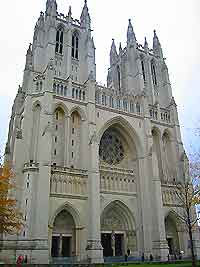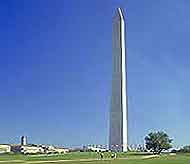Washington History Facts and Timeline
(Washington, District of Columbia - DC, USA)

Washington, the current capital of the United States was founded in 1790, when the Residence Act was passed by Congress as the seat of the United States government. This permitted the settling of a national capital outside the already established states in North America and was done for safety and security reasons, after an anti-government protest of 1783 outside the former federal government building, which is today known as the Pennsylvania Mutiny.
Land was given by the states of
Maryland and Virginia for the building of a settlement along the banks of the Potomac River. However, President George Washington sealed the deal with his choice for the exact location. Eventually, the first Congress meeting in Washington was held in 1801, between the already established towns of Georgetown and Alexandria.
When the layout of Washington DC was first structured in the late 18th century, the surveyor, Benjamin Banneker, allegedly placed large boulders outlining the diamond shape of the original city. Today, many of the actual stones used in the first survey can still be seen, providing a glimpse of the founding of the city several centuries ago in local history. The DC part refers to 'District Columbia', since Columbia was a popular term at the time for the federated states.
Conflicts of the 19th Century
The newly formed capital experienced its fair share of conflicts. In 1814, British soldiers set fire to and destroyed the Presidential Mansion (later renamed the White House) among other buildings, prompting a temporary movement of Congress. In the 1830s, the southern area of the city, Alexandria, suffered from economic depression, and by 1846, it was returned to Virginia after years of local lobbying, ruining the original 'diamond shape' of Washington DC.

Post-Civil War Era
The American Civil War (1861 to 1865) led to an explosion of the city's population, especially of its African-American citizens. Even after the Civil War ended, the population continued to expand, but the city lacked basic infrastructure and sanitation. In fact, the issue of slavery had an important bearing on the city, since the Compromise of 1850 (there were several 'Compromise' acts) outlawed slavery and freed some 3,000 slaves.
The Organic Act of 1871 led to a plethora of significant developments in the history of Washington DC, including the introduction of motorized street cars in 1888 and the opening of the Washington Union Station in 1907. Many urban renewal schemes took off, including the construction of the National Mall and other government buildings in early 20th-century history. The National Mall, which contains dozens of landmarks, such as the Lincoln Memorial, the Vietnam Veterans Memorial and various museums, is a significant landmark even today.
One of the more popular historical sites in the city is Ford's Theater. Step back in time and tour the famous theater where President Lincoln was shot in 1865. This event not only had a profound and lasting effect on Washington DC, but on the entire nation.
Civil Rights Riots
Washington DC, with its predominantly black population, experienced riots around the U Street district after civil rights activist Dr. Martin Luther King was assassinated in
Memphis on 4th April 1968. This was one of several race riots experienced in the city during this period of history.
Segregation was implemented by the local government from 1868 until the mid-1950s. The city saw its first mayoral elections in 1973, which elected one Walter Washington - strangely enough, and this African American became the very first mayor. However, until 1961 residents of DC did not get to vote in the Electoral College that chose the President. Even today they do not have representation in Congress.
Most recently Washington DC was part of the targeted attacks of 9/11, when terrorists flew a hijacked plane into the Pentagon, causing considerable damage.
 Washington, the current capital of the United States was founded in 1790, when the Residence Act was passed by Congress as the seat of the United States government. This permitted the settling of a national capital outside the already established states in North America and was done for safety and security reasons, after an anti-government protest of 1783 outside the former federal government building, which is today known as the Pennsylvania Mutiny.
Washington, the current capital of the United States was founded in 1790, when the Residence Act was passed by Congress as the seat of the United States government. This permitted the settling of a national capital outside the already established states in North America and was done for safety and security reasons, after an anti-government protest of 1783 outside the former federal government building, which is today known as the Pennsylvania Mutiny.